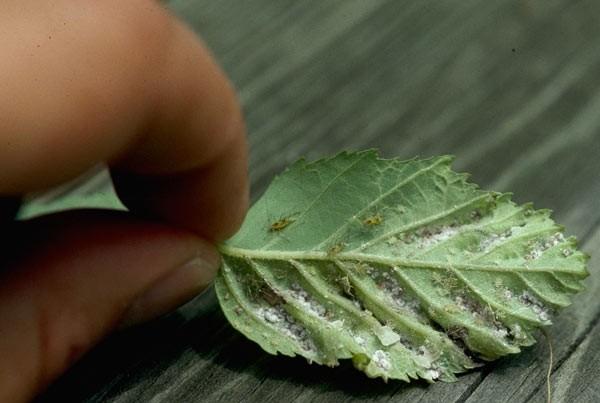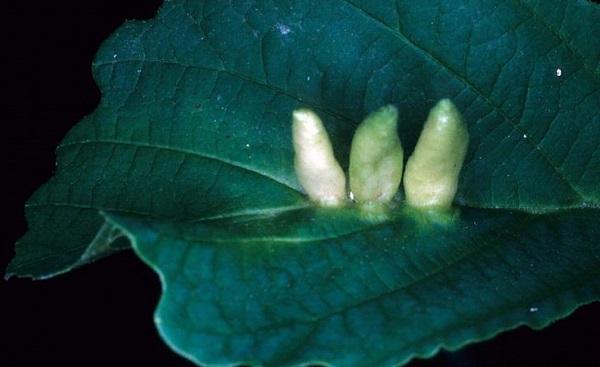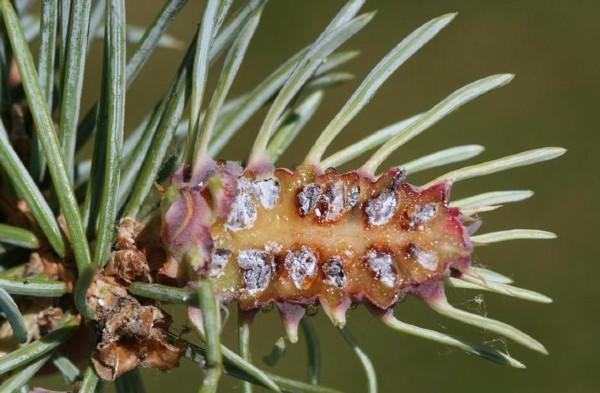Galls are unusual growths on tree leaves or branches. They are caused by insects. They are unsightly but not life-threatening to the trees.
How are galls formed?
Galls are abnormal swellings of plant tissue, usually on leaves and twigs. Insects, mites, bacteria, fungi, or nematodes may cause them. Chemicals produced by the egg-laying and feeding activities cause most insect and mite galls. The chemicals cause the affected plant cells to swell. Aphids, midges, wasps, psyllids, beetles, and eriophyid mites can cause galls.
Are galls harmful?
Galls may disfigure twigs and foliage, but they do not seriously affect the health of trees and shrubs. Chemical control is usually not recommended. If a plant appears unhealthy, search for additional causes such as cultural problems or diseases.
Common types of galls
Maple bladder gall

Maple bladdergall
Photo: Joseph OBrien, USDA Forest Service, Bugwood.org
This gall is caused by an eriophyid mite and is generally found on silver and red maple. These galls rarely require treatment. If desired, spray trees with horticultural oil at the dormant rate before bud break in the spring. Once the galls have formed on leaves, it is too late for treatment.
Hickory leaf stem gall

Photo: Lacy L. Hyche, Auburn University, Bugwood.org
This gall is caused by an aphid (Phylloxera caryaecaulis). Spray trees with horticultural oil at the dormant rate in late spring just as new growth begins. Sprays are not effective once the galls begin to develop.
witch hazel aphids


Photo: Lacy L. Hyche, Auburn University, Bugwood.org
The Spiny Witch Hazel Gall Aphid (Hamamelistes spinosus) is a common pest on birch, particularly river birch (Betula nigra). Injury from this aphid ranges from premature leaf drop to dead twigs and branches. It has a complicated life cycle in that alternates between two hosts: birch (Betula) and witch hazel (Hamamelis). The aphids become active in the spring when the leaf buds are opening. The growth and reproduction of the aphids is rapid, and the birch leaves soon develop characteristic “corrugations” or pleats. The corrugations on the undersides of the leaves fill with aphids and a white granular material. Winged aphids develop on the birch leaves then seek a witch hazel on which to lay eggs and complete the life cycle. Egg-laying prompts the growth of the galls on witch hazel. This activity takes place before the end of June. The Witch Hazel Cone Gall Aphid (Hormaphis hamamelidis) creates cone-shaped galls on witch hazel foliage, and similarly may use birch as an alternate host.
Cooley spruce gall

Cross-section of gall with developing Cooley spruce gall adelgids
Photo: Whitney Cranshaw, Colorado State University, Bugwood.org
Pineapple-like galls on the tips of blue spruce and Douglas fir are caused by an adelgid (aphid-like insect). Spray with a horticultural oil at the dormant rate before bud break in March, or use the summer rate in early April, or July-August. Prune out small infestations in summer.
Eastern spruce gall

Photo: Lorraine Graney, Bartlett Tree Experts, Bugwood.org
Galls on the bases of twigs of Norway and white spruce and occasionally black and red spruce are also caused by an adelgid. Spray with a horticultural oil at the dormant rate just before bud break in March, or spray the summer rate in July to August just as the galls open. Prune out green galls in summer.
Management of insects that cause galls
To prevent completion of the insect or mite life cycle, prune out twig and stem galls while they are green. Small holes in the gall indicate that the inhabitants already have escaped repeating the life cycle.
You can examine the undersides of leaves for beneficial insects such as ladybird (ladybugs) beetles and their larvae, flower fly larvae, lacewing eggs and larvae, and parasite activity. Any combination of these predators and parasites can give sufficient control without having to spray with an insecticide. These are not serious pests. If damage is heavy or the tree is young, spray with horticulture oil. Coverage of the lower surfaces of the leaves is critical, as the insects are fairly protected in the corrugated folds of the leaves.
Author: John A. Davidson (retired), Extension Entomologist, University of Maryland.
Revised: Mary Kay Malinoski, University of Maryland Extension Specialist, Home and Garden Information Center (retired)
Rev. 2020
